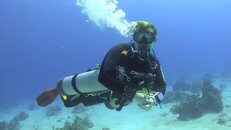Bob,
Our Essentials of Side Mount class teaches the same personal skills as the back mount class: proper weighting, buoyancy, trim, propulsion, s-drills, smb. Essentials of Tech adds valve drills and gas switch. Essentials of Overhead doesn't teach gas switch, but does teach basic line handling.
In the side mount classes we also spend time on gear fitting, failures specific to the UTD side mount configuration, scaling the system up and down, and gas management (if on doubles).
In our Side Mount Mini, we don't dig into the personal skills, as we expect those skills to be in order for the student coming it. In the mini, we just do the side mount specific training as noted above, and geared to the students' current level of diving.
All the Essentials classes can be taught to a mixed team, back mount or side mount, as the personal skills and emergency procedures are the same.
Jeff
Our Essentials of Side Mount class teaches the same personal skills as the back mount class: proper weighting, buoyancy, trim, propulsion, s-drills, smb. Essentials of Tech adds valve drills and gas switch. Essentials of Overhead doesn't teach gas switch, but does teach basic line handling.
In the side mount classes we also spend time on gear fitting, failures specific to the UTD side mount configuration, scaling the system up and down, and gas management (if on doubles).
In our Side Mount Mini, we don't dig into the personal skills, as we expect those skills to be in order for the student coming it. In the mini, we just do the side mount specific training as noted above, and geared to the students' current level of diving.
All the Essentials classes can be taught to a mixed team, back mount or side mount, as the personal skills and emergency procedures are the same.
Jeff





